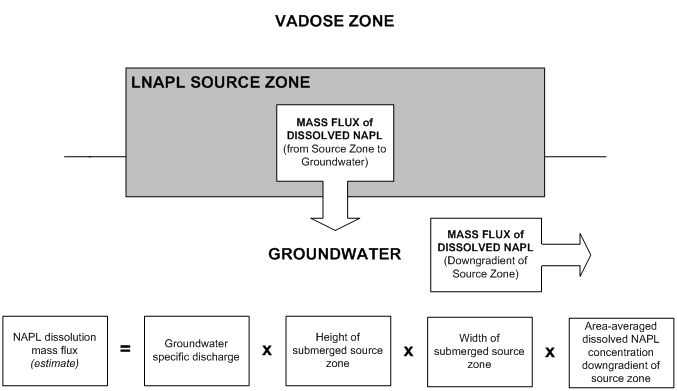Applied NAPL Science Review
Demystifying NAPL Science for the Remediation Manager
ANSR Scientific Review Board
J. Michael Hawthorne, PG, Board of Chairman, GEI Consultants Inc.
Mark Adamski, PG, BP Americas
Dr. Randall Charbeneau, University of Texas
Dr. Sanjay Garg, Shell Global Solutions (US) Inc.
Dr. Terrence Johnson, USEPA
Andrew J. Kirkman, PE, AECOM
Mark W. Malander, ExxonMobil Environmental Services
Applied NAPL Science Review (ANSR) is a scientific ejournal that provides insight into the science behind the characterization and remediation of Non-Aqueous Phase Liquids (NAPLs) using plain English. We welcome feedback, suggestions for future topics, questions, and recommended links to NAPL resources. All submittals should be sent to the editor.
LNAPL Natural Source Zone Depletion, Part 2:
Calculation of Mass Loss Rate
(Submerged Source Zone)
Texas Commission on Environmental Quality
Part 1 of this series describes some qualitative assessment aspects of LNAPL natural source zone depletion (NSZD), including some NSZD processes and methods to confirm their occurrence. This second part describes one of a number of quantitative assessment methods by which to calculate the rate of mass loss from LNAPL source zones.
The source zone mass loss rate via NSZD can be useful when estimating a baseline for comparison against recovery rates of engineered systems.
NSZD Mass Loss Rates
A quantitative NSZD assessment includes an estimate of the current instantaneous mass depletion rate from the LNAPL source zone. The total mass depletion rate accounts for source zone mass flux to the aqueous phase (groundwater), mass flux to the vapor phase (soil gas) and mass consumed via biodegradation in both groundwater and the vadose zone. For reasons discussed below, the estimate of NSZD mass loss rates is instantaneous because the rate usually decreases over time.
An estimate of the NSZD mass loss rate is based on evaluating the mass flux associated with each of the LNAPL NSZD processes (see Part 1 for additional discussion). Such a mass flux accounting is performed separately on control volumes for the submerged and the exposed portions of the source zone (Figure 1).

Figure 1: Generalized balance of mass flux into and out of control volumes of the submerged and exposed portions of the LNAPL source zone (from ITRC, 2009).
Calculation of NSZD Rates for Submerged LNAPL Source Zone
NSZD mass loss rates for the submerged source zone include: 1) rate of dissolved LNAPL mass leaving the source zone via groundwater and 2) rate of LNAPL mass biodegraded in the source zone. Figure 2 is a general reference figure for mass loss calculations for a submerged LNAPL source zone. A future part 3 of this series details the mass loss calculations for exposed (i.e., not submerged) LNAPL source zones.

Figure 2: Summary of dissolved mass loss components for submerged LNAPL source zone and basis for Equation 1 (from ITRC, 2009).
Equation 1 calculates an estimate of submerged LNAPL source zone mass loss by dissolution to groundwater (parameter definitions in Appendix A).
![]()
Groundwater dissolved TPH concentration data should be collected from monitoring wells placed at the upgradient and downgradient edges of the submerged source zone control volume. Figure 3 shows acceptable locations of upgradient and downgradient monitoring wells at a hypothetical LNAPL release site.

Figure 3: Appropriate locations of monitoring wells placed at the edge of the LNAPL source zone control volume for collection of NSZD data (modified from ITRC, 2009).
Figure 4 summarizes the calculation used to estimate the mass loss rate from a submerged LNAPL source zone via biodegradation. Equation A.2 in Appendix A is the mathematical expression of Figure 3 and can be used to calculate the LNAPL source zone mass loss rate via biodegradation.
Spreadsheet A can be used to calculate an estimate of the total NSZD mass loss rate in the submerged source zone.

Figure 4: Graphical summary of calculation used to estimate mass loss rate from submerged LNAPL source zone due to biodegradation zone (from ITRC, 2009).
Figure 5 depicts the expected changes in groundwater geochemistry due to TPH biodegradation between the upgradient and downgradient edges of the LNAPL source zone control volume.

Figure 5: Changes of biodegradation transformation products and TPH concentrations downgradient of LNAPL source zone relative to those upgradient of source zone (from ITRC, 2009).
Application of NSZD Rates
NSZD rates can be useful in establishing a reference benchmark for source zone mass loss against which the efficacy of alternative remedies may be compared. Source zone mass loss rates can provide information on effectiveness of different NSZD processes that can direct remedial strategies.
References:
ITRC 2009 Evaluating Natural Source Zone Depletion at Sites with LNAPL, LNAPL-1, Technology Overview, Interstate Technology & Regulatory Council, Washington D.C., 76 pp.
[Additional references in: https://www.itrcweb.org/Documents/LNAPL-1.pdf]
Johnson P.C., Bruce C., Johnson R.L. and Kemblowski M.W. 1998 In situ measurement of effective vapor-phase porous medium diffusion coefficients, Environmental Science and Technology 32, pg 3405 – 3409.
Johnson P.C., Lundegard P. and Liu Z. 2006 Source zone natural attenuation at petroleum hydrocarbon spill sites: I. Site-specific assessment approach, Ground Water Monitoring and Remediation 26, pg 82 – 92.
Appendix A – Equations for Calculation of NSZD Rates for Submerged LNAPL Source Zone
NSZD rate of LNAPL mass dissolved in groundwater
![]()
[Equation A.1]
Where:

NSZD rate of LNAPL mass biodegraded in groundwater
Equation 2 is the mathematical expression of Figure 3 and can be used to calculate the LNAPL source zone mass loss rate via biodegradation.
![]()
[Equation A.2]

Where:

Real World Limitations: A word of caution – natural source zone depletion (NSZD) is an important but complex process that includes many variables. While NSZD can be an effective, natural control on NAPL source zone mass, NSZD cannot be blindly relied upon as a control for LNAPL, dissolved phase, or vapor phase migration without detailed investigation and demonstration of its applicability at any given site. Identification of the occurrence of NSZD is an important part of a site’s LNAPL Conceptual Site Model (LCSM) and may be an important component of a site remedy, subject to testing and verification.
